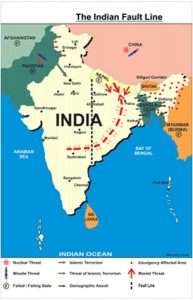Terror is the Key
Speaking on the anti-Maoist operation, one of the high government functionaries in Bihar quipped that we have to be lucky all the time while the Maoists have to be lucky only once.
Both in the Maoist affected areas of Jharkhand and Bihar, the level of intimidation and violence perpetrated by the Maoists has created terror amongst the people. In fact, a whole generation has grown up in this atmosphere. Therefore, the Maoist violence is not a mere question of casualties and violent incidents. It is about terror, which is as ugly and vicious as the terror industry of Taliban. The Maoists do not give a symbolic window for any reprieve as in the case of Islamic terrorism after the killing of Osama bin Laden.
Operation Green Hunt has so far failed in delivering people from fear. The bandh call given by the Maoists is hardly contested rather they are becoming increasingly frequent. A government functionary in Bihar was candid enough to admit that the administration does not contest Maoist bandhs for fear of casualties to common people. This author traveled on Ranchi-Jamshedpur road during one such bandh. Business was paralyzed and terror was palpable.
 The Maoist threat in rural areas of Jharkhand and some areas of Bihar has compelled professionals like doctors and teachers to shift to middle level and district towns for security. It is one of the reasons for escalation of property prices in the urban areas.The methods used by the Maoists to silence detractors are so gruesome that the people are terrorized forever. Many of them are meted out in full public view in the ‘Jan Adalats’. It is all done to terrorize the people to increase the spread of the Maoist terror and extortion territory. Even in moderately affected areas, the terror factor is high. The Maoists have graduated to calling railway bandhs. India has capitulated. In last railway bandh called by the Maoists more than 20 trains were either cancelled or diverted. In many areas, night trains have been discontinued with.
The Maoist threat in rural areas of Jharkhand and some areas of Bihar has compelled professionals like doctors and teachers to shift to middle level and district towns for security. It is one of the reasons for escalation of property prices in the urban areas.The methods used by the Maoists to silence detractors are so gruesome that the people are terrorized forever. Many of them are meted out in full public view in the ‘Jan Adalats’. It is all done to terrorize the people to increase the spread of the Maoist terror and extortion territory. Even in moderately affected areas, the terror factor is high. The Maoists have graduated to calling railway bandhs. India has capitulated. In last railway bandh called by the Maoists more than 20 trains were either cancelled or diverted. In many areas, night trains have been discontinued with.
One police official in Bihar lamented the fact that while the judiciary does not spare criminals, hard-core Maoists charged with dozens of murders are being granted bail. They come back only to unleash fresh round of terror.
Army was deployed in Punjab and continues to be so in Assam, Northeast and Kashmir. Never before, the phraseology “insurgents being own people, and not enemies” has so skillfully and irresponsibly been bandied before.
The Maoist expansion is primarily by means of terror, propaganda and indoctrination are only vehicles. The Red Corridor has been paved through Chhattisgarh, Orissa and Jharkhand, not for reasons of underdevelopment, but because the strategic advantages that the terrain bestows for armed insurrection.
While the forests provide cover, isolation and insulation, the minerals provide the wealth. The area is an ideal ‘red base’ or ‘liberated zone’ to expand influence, and to fall back when pushed. It is pure military strategy, tribal disaffection is only a ruse.
Nothing stings the Maoist leadership as much as any group which rises to fight Maoist terror. The leadership then, apart from armed cadres, activates all its urban leverages in the intelligentsia, media, and judiciary.
In Jharkhand, people were of the opinion that the rapid expansion of Maoists in the state was because there were no resistance groups like ‘Salwan Juddum’ in Chhattisgarh or Ranvir Sena in Bihar. People in Bihar, including government functionaries said that but for Ranvir Sena in the 80s and 90s the entire state would have been taken over by the Maoists.
Government officials in Jharkhand also said that unlike Chhattisgarh, there was no displacement of population in Jharkhand on account of Maoist violence, primarily because the Maoist local and middle level leadership has traditionally been with the locals, who are part of the fabric of the society.
Government officials in Jharkhand also said that unlike Chhattisgarh, there was no displacement of population in Jharkhand on account of Maoist violence, primarily because the Maoist local and middle level leadership has traditionally been with the locals, who are part of the fabric of the society. They therefore, have affinities and also vulnerabilities. In Chhattisgarh, however, the leadership is from Andhra and lately also from Bihar. This leadership has no sense of belonging with the locals and therefore is very cruel in its methods. It sees things only in black and white. Those whom they perceive to be the black category are tortured, maimed and killed. To escape the Maoist terror, thousands have fled their villages, to find shelter in Salwan Juddum camps.
Taking leaf out of Mao’s revolution in China, the Maoists deliberately create their strongholds in the interstate junctions or tri-junctions in order to exploit the lack of coordination, weakness and diverse approach of different states in tackling Maoist terrorism. That is why the region of tri-junction of Andhra, Chhattisgarh and Orissa remains the most formidable stronghold of the Maoists. Geographically, Jharkhand is most vulnerable as almost all 24 districts have borders with other states. The areas of Bihar that border with Jharkhand are worst affected. Good governance by the state government has made very feeble dents. These areas are Aurangabad, Gaya and Sassaram. But, as one moves away farther from these areas, the feature of governance, which includes vigilant policing, has made tremendous impact.
The authorities in both the states, Jharkhand and Bihar, do not give much accent to the pan-India dimension of the Maoists problem. Their approach continues to be of that “law and order” problem rather than “insurgency”. While the Maoists cadres have time and again displayed tremendous mobility in the Red Corridor, the affected states are severely hamstrung by boundaries and territorial jurisdiction issues. However, they are loathe to accept the same and insist that there is indeed cooperation between the various states in coordinating anti-Maoist operation. Such claims have no robust and tangible manifestations so far.
The Strategic Dimension
While the Union Home Ministry and the law and order apparatus of various states focus on the internal security aspects, there are overwhelming strategic ramifications of the Maoist problem as far as the armed forces are concerned, but have not been dovetailed into the anti-Maoist response of the state. The MoD and the armed forces can allow this state of affairs to continue at the peril of India.
 Considering the pan-Indian nature of Maoist terrorism through the heart of India, the strategic dimension of the Maoist threat is most pernicious. Apart from containing strategic minerals, the Red Corridor dominates the entire road and rail communication links connecting the eastern part of India, extending upto our frontiers with China. The Maoists, with their enormous IED resources have shown their ability to severely disrupt communications to the eastern part of India. This is the vulnerability, which can cost dearly in the event of hostilities with China and even Pakistan, as these communications serve as the precarious logistics links, and for switching over forces from one theatre to another.
Considering the pan-Indian nature of Maoist terrorism through the heart of India, the strategic dimension of the Maoist threat is most pernicious. Apart from containing strategic minerals, the Red Corridor dominates the entire road and rail communication links connecting the eastern part of India, extending upto our frontiers with China. The Maoists, with their enormous IED resources have shown their ability to severely disrupt communications to the eastern part of India. This is the vulnerability, which can cost dearly in the event of hostilities with China and even Pakistan, as these communications serve as the precarious logistics links, and for switching over forces from one theatre to another.




